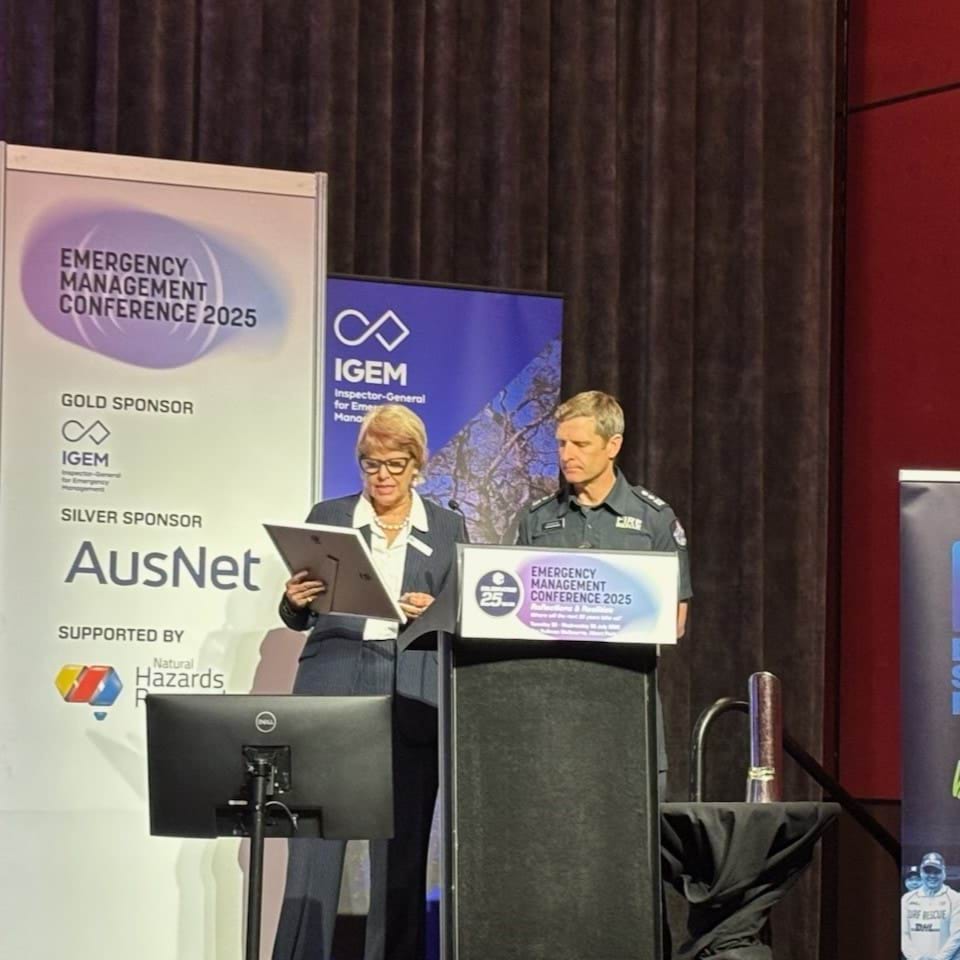- Published:
- Tuesday 2 September 2025 at 11:03 am
Fire Rescue Victoria (FRV) staff joined fellow first responders for the 25th Emergency Management Conference (EMC) at Albert Park, Melbourne, recently.
Organised by the Emergency Services Foundation (ESF), the two-day event was themed ‘Reflections and Realities – Where will the next 25 years take us?”
Bringing together professionals and experts in emergency management, the conference touched on subjects including mental health, diversity, climate change, community engagement, response and recovery.
Participating FRV staff included:
• Fire Rescue Commissioner Gavin Freeman AFSM who joined a panel of experts to discuss and answer questions on ‘Inclusion in the emergency management sector’.
• Deputy Commissioner Michael Morgan AFSM who put questions to the Inclusion and Diversity Panel.
• Assistant Chief Fire Officer Mark Swiney who was Conference Chair.
• Assistant Chief Fire Officer Dennis Smith who was Chair for a discussion by Joe Buffone of the National Emergency Management Agency entitled ‘Looking back to look forward’ about the impact of the past 25 years.
• Assistant Chief Fire Officer Regional Commander Mark Gunning who presented on behalf of the Country Fire Authority (CFA) on ‘Mobilising an army of agencies and communities’.
• Commander David Clancy who presented on ‘Managing the complexities of Neurodivergence in emergency management.
• Senior Station Officer Matthew Nicholson who presented on ‘Fatigue within emergency services’.
• Leading Firefighter Stuart Radley who spoke about the benefits of the ‘ESF Lived Experience Program’ during the presentation by ESF CEO Siusan MacKenzie.
• Senior Manager Diversity and Inclusion Jessie Fraser who joined the discussion on ‘Inclusion in the emergency management sector’.
• Chaplain Jesse Winter who presented on ‘Understanding and recovering from moral injury’.
• Cultural Engagement Advisor Ruth Harley who co-presented ‘Utilising the voice of the community’ with Ellisa Bourne of the CFA.
Key presentations included:
‘Mobilising an army of agencies and communities’ - Assistant Chief Fire Officer Regional Commander Mark Gunning
Presenting on behalf of the CFA, seconded FRV ACFO Mark Gunning gave an insight into how communities worked together to minimise loss and damage in the fires in the western district of Victoria, which began on Boxing Day, 26 December 2024.
ACFO Gunning highlighted the importance of engagement across all relevant communities, networks and agencies and in the run-up to the fires, to optimise response and recovery.
Key takeaways highlighted that affected communities are experiencing more destructive fires more often, with quicker and more severe impacts. While fire and emergency services cannot meet all community needs during a large-scale emergency, a shared approach involving communities in response and recovery needs to be built and maintained to be successful.
Understanding and Recovering from Moral Injury – Chaplain Jesse Winter
Chaplain Jesse Winter presented on what moral injury is and how it affects Australian emergency services personnel.
Moral injury is an injury to an individual’s values, and has serious links to mental health concerns, including increased suicidality and treatment-resistant PTSD.
The presentation focused on the unique challenges faced by first responders, who experience career-long, cumulative exposure to potentially morally injurious events.
Jesse discussed how current support frameworks may fall short. He outlined the benefits of an interdisciplinary model of care that integrates the complementary strengths of psychology and chaplaincy.
The approach is informed by Jesse’s recent study tour, which included insights from leading international research, expert consultations, and the lived experiences of first responders experiencing moral injury.
‘Managing Complexities of Neurodivergence in Emergency Management: Creating an Inclusive Environment’ - Commander David Clancy
Commander Clancy’s presentation focused on the many reasons why integrating neurodiversity into emergency management is important.
When people with different ways of thinking come together, they can create new ideas, leading to better solutions during emergencies.
For example, someone who sees the details that others may miss can help find new ways to manage emergencies and including neurodiverse people in planning can help reduce biases.
By welcoming various voices, emergency teams can ensure that they consider all views and promote inclusive decision-making.
Commander Clancy concluded that including neurodiverse people in emergency management not only triggers creativity and reduces biases, but it also guarantees that everyone feels represented.
This leads to better security and resilience for emergency responders as a whole.
‘Fatigue within Emergency Services’ - Senior Station Officer Matthew Nicholson
SSO Matthew Nicholson’s presentation focused on fatigue within the emergency services.
It explored the high prevalence of sleep disorders in the sector and highlighted the significant physical and mental toll this is taking on personnel.
As a joint recipient of the 2024 ESF Scholarship, SSO Nicholson has been able to further investigate fatigue management strategies, to gain a deep understanding of this critical issue.
In a society that increasingly relies on first responders to deal with potentially traumatic events, it is vital to protect those who protect us, said SSO Nicholson, beginning with better education around sleep science and increased investment in resources in emergency services.
SSO Nicholson concluded that addressing fatigue is not the responsibility of individuals alone—it requires a shared commitment from both leadership and frontline personnel with a sector-wide approach to effectively manage this pervasive hazard.
‘Utilising the voice of the community - Key Lessons in Multicultural Fire safety Resource Development’, co-presented by Cultural Engagement Advisor Ruth Harley
In this presentation, Ruth and co-presenter Ellisa Bourne of the CFA shared insights and learnings from developing fire safety resources specifically for Victorian multicultural communities.
It drew on the experience of developing a multi-year project plan for multicultural communication, including working with focus groups, to develop fire safety resources including summer fire safety and smoke alarm animations along with stakeholder kits.
The in-language videos created featured community members and were meticulously checked to ensure that the messages were in context and understandable to their audiences.
The presentation concluded that while working with multicultural communities requires time and investment to achieve optimum results, it offers the opportunity to distribute vital public safety messaging through significant and relatable engagement.
Updated


